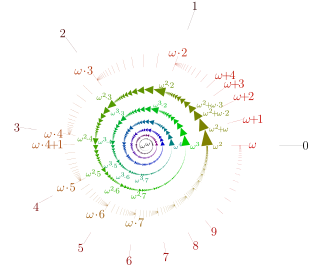
A hierarchy is an arrangement of items that are represented as being "above", "below", or "at the same level as" one another. Hierarchy is an important concept in a wide variety of fields, such as architecture, philosophy, design, mathematics, computer science, organizational theory, systems theory, systematic biology, and the social sciences.

In mathematics, the natural numbers are the numbers 0, 1, 2, 3, etc., possibly excluding 0. Some define the natural numbers as the non-negative integers0, 1, 2, 3, ..., while others define them as the positive integers1, 2, 3, .... Some authors acknowledge both definitions whenever convenient. Some texts define the whole numbers as the natural numbers together with zero, excluding zero from the natural numbers, while in other writings, the whole numbers refer to all of the integers. The counting numbers refer to the natural numbers in common language, particularly in primary school education, and are similarly ambiguous although typically exclude zero.

In mathematics, especially order theory, a partial order on a set is an arrangement such that, for certain pairs of elements, one precedes the other. The word partial is used to indicate that not every pair of elements needs to be comparable; that is, there may be pairs for which neither element precedes the other. Partial orders thus generalize total orders, in which every pair is comparable.
In mathematics, a well-order on a set S is a total ordering on S with the property that every non-empty subset of S has a least element in this ordering. The set S together with the ordering is then called a well-ordered set. In some academic articles and textbooks these terms are instead written as wellorder, wellordered, and wellordering or well order, well ordered, and well ordering.

In mathematics, particularly in set theory, the aleph numbers are a sequence of numbers used to represent the cardinality of infinite sets that can be well-ordered. They were introduced by the mathematician Georg Cantor and are named after the symbol he used to denote them, the Hebrew letter aleph (ℵ).
Reverse mathematics is a program in mathematical logic that seeks to determine which axioms are required to prove theorems of mathematics. Its defining method can briefly be described as "going backwards from the theorems to the axioms", in contrast to the ordinary mathematical practice of deriving theorems from axioms. It can be conceptualized as sculpting out necessary conditions from sufficient ones.
In set theory and related branches of mathematics, the von Neumann universe, or von Neumann hierarchy of sets, denoted by V, is the class of hereditary well-founded sets. This collection, which is formalized by Zermelo–Fraenkel set theory (ZFC), is often used to provide an interpretation or motivation of the axioms of ZFC. The concept is named after John von Neumann, although it was first published by Ernst Zermelo in 1930.
In mathematics, specifically order theory, a well-quasi-ordering or wqo on a set is a quasi-ordering of for which every infinite sequence of elements from contains an increasing pair with
In the mathematical discipline of set theory, there are many ways of describing specific countable ordinals. The smallest ones can be usefully and non-circularly expressed in terms of their Cantor normal forms. Beyond that, many ordinals of relevance to proof theory still have computable ordinal notations. However, it is not possible to decide effectively whether a given putative ordinal notation is a notation or not ; various more-concrete ways of defining ordinals that definitely have notations are available.
In descriptive set theory, within mathematics, Wadge degrees are levels of complexity for sets of reals. Sets are compared by continuous reductions. The Wadge hierarchy is the structure of Wadge degrees. These concepts are named after William W. Wadge.
An approach to the foundations of mathematics that is of relatively recent origin, Scott–Potter set theory is a collection of nested axiomatic set theories set out by the philosopher Michael Potter, building on earlier work by the mathematician Dana Scott and the philosopher George Boolos.
In descriptive set theory, the Kleene–Brouwer order or Lusin–Sierpiński order is a linear order on finite sequences over some linearly ordered set , that differs from the more commonly used lexicographic order in how it handles the case when one sequence is a prefix of the other. In the Kleene–Brouwer order, the prefix is later than the longer sequence containing it, rather than earlier.
In computability theory, hyperarithmetic theory is a generalization of Turing computability. It has close connections with definability in second-order arithmetic and with weak systems of set theory such as Kripke–Platek set theory. It is an important tool in effective descriptive set theory.
In proof theory, ordinal analysis assigns ordinals to mathematical theories as a measure of their strength. If theories have the same proof-theoretic ordinal they are often equiconsistent, and if one theory has a larger proof-theoretic ordinal than another it can often prove the consistency of the second theory.
Order in mathematics may refer to:
In computability theory, computational complexity theory and proof theory, a fast-growing hierarchy is an ordinal-indexed family of rapidly increasing functions fα: N → N. A primary example is the Wainer hierarchy, or Löb–Wainer hierarchy, which is an extension to all α < ε0. Such hierarchies provide a natural way to classify computable functions according to rate-of-growth and computational complexity.
In set theory and mathematical logic, the Lévy hierarchy, introduced by Azriel Lévy in 1965, is a hierarchy of formulas in the formal language of the Zermelo–Fraenkel set theory, which is typically called just the language of set theory. This is analogous to the arithmetical hierarchy, which provides a similar classification for sentences of the language of arithmetic.

In set theory, an ordinal number, or ordinal, is a generalization of ordinal numerals aimed to extend enumeration to infinite sets.
This is a glossary of set theory.




